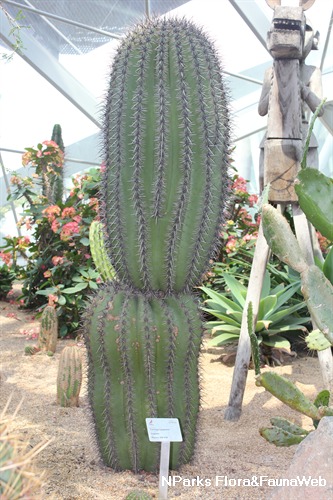
Back
Carnegiea gigantea (Engelm.) Britton & Rose
| Family Name: | Cactaceae |
| Synonyms: | Cereus giganteus |
| Common Name: | Saguaro Cactus, Giant Cactus |
Name
Classifications and Characteristics
| Plant Division | Angiosperms (Flowering Seed Plants) (Dicotyledon) |
|---|---|
| Plant Growth Form | Herbaceous Plant, Succulent Plant |
| Lifespan (in Singapore) | Perennial |
| Mode of Nutrition | Autotrophic |
| Plant Shape | Columnar |
| Maximum Height | 16 m |
| Tree or Palm – Trunk Diameter | 75 cm |
Biogeography
| Native Distribution | Mexico, SW USA |
|---|---|
| Native Habitat | Terrestrial |
| Preferred Climate Zone | Desert / Arid |
| Local Conservation Status | Non-native (Horticultural / Cultivated Only) |
Description and Ethnobotany
| Growth Form | Large columnar cactus which forms arm-like branches. |
|---|---|
| Stems | The greyish green stem is composed of 12-30 ribs which are densely armed with clusters of white conical spines with black tips (up to 3.8 cm long). The stem expands like an accordion during the rainy season. The side branches begin to emerge after 50-70 years of growth. |
| Flowers | White, funnel-shaped flowers (8.5-12.5 cm long, 5-6 cm wide) are produced directly on the stem. The night-blooming flowers are primarily pollinated by bats, but bees and dove also help to pollinate in the early morning. This species begins to flower after 30-35 years of growth. |
| Fruit | Red, edible fruits (5-7.5 cm long, 2.5-4.4 cm wide) contain red, juicy flesh and numerous, tiny, black seeds. |
| Etymology | The genus Carnegiea was name after American tycoon and philanthropist Andrew Carnegie (1835-1919). |
| Ethnobotanical Uses | Edible Plant Parts : Edible Fruits, Edible Seeds Food (Fruit or Vegetable): The Native American Indians consumed the fruits raw or used them to make syrups, wine, jam, vinegar and juice. The seeds were ground into flour for making cakes. |
Landscaping Features
| Desirable Plant Features | Ornamental Form |
|---|---|
| Thematic Landscaping | Rockery / Desert Garden |
| Usage Hazard - Cons | Spines/Thorns - Stem/Branch |
Fauna, Pollination and Dispersal
| Fauna Pollination Dispersal Associated Fauna | Bat Food |
|---|---|
| Pollination Method(s) | Biotic (Fauna) (Insects (Bee), Vertebrates (Bird), Vertebrates (Bat)) |
| Seed or Spore Dispersal | Biotic (Fauna) (Vertebrates (Other Mammal)) |
Plant Care and Propagation
| Light Preference | Full Sun |
|---|---|
| Water Preference | Little Water |
| Rootzone Tolerance | Drought Tolerant, Well-Drained Soils |
| Propagation Method | Seed |
Floral (Angiosperm)
| Flower Colour(s) | White |
|---|---|
| Flower Symmetry | Radial |
| Flowering Opening Time | Night (dusk to dawn) |
Fruit, Seed and Spore
| Mature Fruit Colour(s) | Red |
|---|---|
| Fruit Classification | Simple Fruit |
| Fruit Type | Fleshy Fruit |
| Mature Seed Colour(s) | Black |
| Mature Seed Texture(s) | Smooth, Glossy / Shiny |
| Seed Quantity Per Fruit | Numerous (>20) |
Image Repository
Others
| Master ID | 31924 |
|---|---|
| Species ID | 6326 |
| Flora Disclaimer | The information in this website has been compiled from reliable sources, such as reference works on medicinal plants. It is not a substitute for medical advice or treatment and NParks does not purport to provide any medical advice. Readers should always consult his/her physician before using or consuming a plant for medicinal purposes. |
